
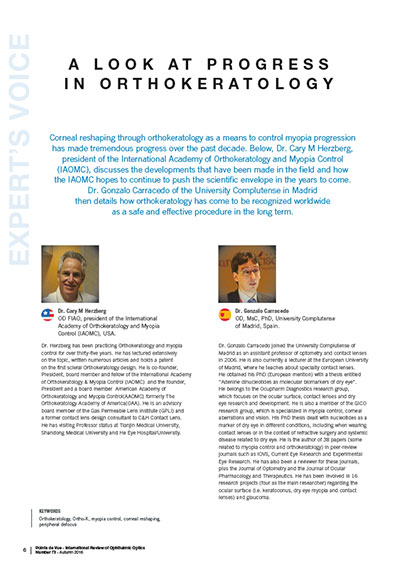 Click here to read the article
Click here to read the article
Corneal reshaping through orthokeratology as a means to control myopia progression has made tremendous progress over the past decade. Below, Dr. Cary M Herzberg, president of the International Academy of Orthokeratology and Myopia Control (IAOMC), discusses the developments that have been made in the field and how the IAOMC hopes to continue to push the scientific envelope in the years to come.
Dr. Gonzalo Carracedo of the University Complutense in Madrid then details how orthokeratology has come to be recognized worldwide as a safe and effective procedure in the long term.
The orthokeratology (Ortho-K) effect was first observed as a side effect of contact lenses made of Poly methyl methacrylate (PMMA), which flattened in their radius of curvature over time. “What started as a method to reduce temporarily the refractive error of nearsighted individuals evolved, with the help of innovative design choices, to advanced engineering of the corneal surface of the eye,” explains Dr. Cary M. Herzberg, OD FIAO, president of the International Academy of Orthokeratology and Myopia Control (IAOMC).
With the optics and resulting aberrations of an oblate corneal surface including spherical aberration, advanced design choices could provide solutions for progressive myopia and presbyopia. Ortho-K also attracted maverick practitioners, who brought a spirit of imaginative innovation to the world. “It has been my honor to have led several of these organizations and to have helped found the international academy, which now spans the globe,” continued Dr. Herzberg. “Our mission is in part to help find solutions to the myopia epidemic which threatens the eye health of present and future generations”.
Article from the magazine "Point de vue"
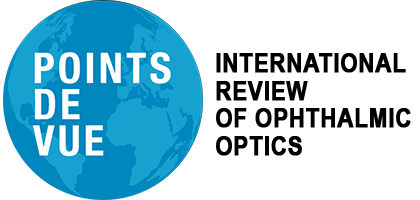
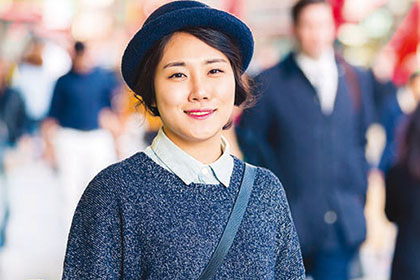
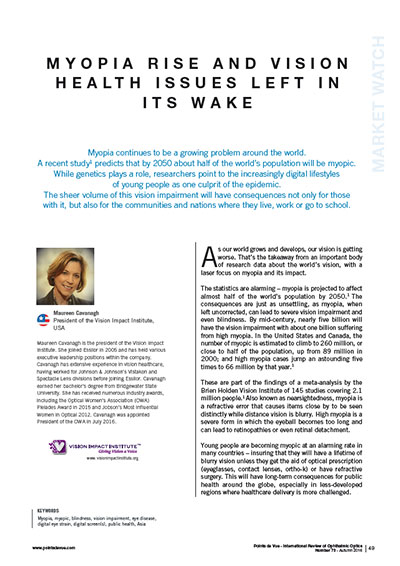 Click here to read the article
Click here to read the article
Myopia continues to be a growing problem around the world. A recent study predicts that by 2050 about half of the world’s population will be myopic.
While genetics plays a role, researchers point to the increasingly digital lifestyles of young people as one culprit of the epidemic.
The sheer volume of this vision impairment will have consequences not only for those with it, but also for the communities and nations where they live, work or go to school.
As our world grows and develops, our vision is getting worse. That’s the takeaway from an important body of research data about the world’s vision, with a laser focus on myopia and its impact.
The statistics are alarming – myopia is projected to affect almost half of the world’s population by 2050. The consequences are just as unsettling, as myopia, when left uncorrected, can lead to severe vision impairment and even blindness. By mid-century, nearly five billion will have the vision impairment with about one billion suffering from high myopia. In the United States and Canada, the number of myopic is estimated to climb to 260 million, or close to half of the population, up from 89 million in 2000; and high myopia cases jump an astounding five times to 66 million by that year.
These are part of the findings of a meta-analysis by the Brien Holden Vision Institute of 145 studies covering 2.1 million people. Also known as nearsightedness, myopia is a refractive error that causes items close by to be seen distinctly while distance vision is blurry. High myopia is a severe form in which the eyeball becomes too long and can lead to retinopathies or even retinal detachment.
Article from the magazine "Point de vue"

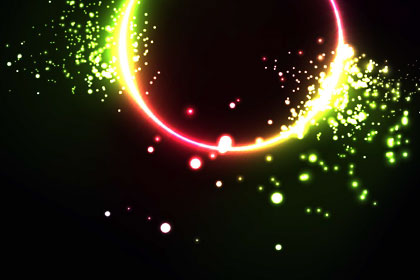
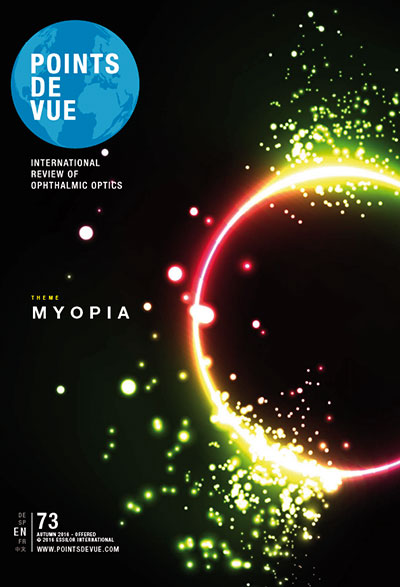 Cliquez ici pour lire l'articleSurprisingly enough for a non-infectious condition, myopia is reaching pandemic proportions across the world.
Cliquez ici pour lire l'articleSurprisingly enough for a non-infectious condition, myopia is reaching pandemic proportions across the world.
Record-breaking figures.
In the US and Europe, the prevalence of myopia has doubled over the last century, reaching 40-50% of young people (aged < 35) today. East Asia has been hit particularly badly. In countries such as Singapore, China and Korea, myopia affects around 80-90% of urban teenagers, compared to 10-20% sixty years ago. Recent work from the Brien Holden Vision Institute (BHVI) estimates that by 2050, five billion people, or half the world’s population, will be myopic and one billion, or 10%, highly myopic. A record-high myopia of -108 diopters has recently been compensated in Slovakia, Europe, representing new challenges for eye care practitioners and the ophthalmic industry. While the direct global socio-economic impact of myopia has not yet been determined, the economic burden of uncorrected refractive error (URE), which is largely caused by myopia, is estimated to be more than US$269 billion (per annum) – and this number is growing as the pandemic spreads.
The good news.
Over the past few months there has been a notable increase in alarming publications in scientific journals and the media on the myopia crisis. However, leading research centers and medical universities have been vigorously focused for some time on furthering understanding of the condition and developing new treatments for it. Etiology investigations have uncovered that myopia onset and its progression in children are correlations of both hereditary (nature) and environmental factors (nurture). The latter can be modified by encouraging greater exposure to natural light through outdoor activities and adopting good reading posture. We take the opportunity in this issue to share some perspectives from 25 experts – scientists and eye care practitioners – taking a look at their approach to understanding, correcting and treating myopia, plus preventing its progression in children.
Hope in sight.
Biochemical research for the myopia pathogenic mechanism will continue to be a hot topic. Luckily, the progress made over the past decade gives us reason for hope. At present, the overwhelming majority of myopia cases can be corrected with regular prescription eyeglasses, contact lenses or refractive surgery. There are also the solutions that correct and control myopia progression in children. Specific multifocal contact lenses, Myopilux® ophthalmic lenses and orthokeratology (Ortho-K) are all recognized as safe and effective procedures in the long term. While pharmacological interventions such as atropine eye drops at low concentration do not correct myopia, they effectively control its progression. There is no doubt tailor-made solutions help patients live their life to the fullest.
TO READ
Article from the magazine "Point de vue"


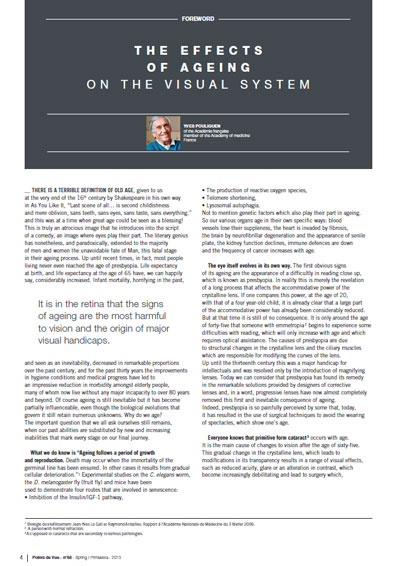 Click here to read the articleIt is in the retina that the signs of ageing are the most harmful to vision and the origin of major visual handicaps.
Click here to read the articleIt is in the retina that the signs of ageing are the most harmful to vision and the origin of major visual handicaps.
THERE IS A TERRIBLE DEFINITION OF OLD AGE, given to us at the very end of the 16th century by Shakespeare in his own way in As You Like It, “Last scene of all… is second childishness
and mere oblivion, sans teeth, sans eyes, sans taste, sans everything.” and this was at a time when great age could be seen as a blessing!
This is truly an atrocious image that he introduces into the script of a comedy, an image where eyes play their part. The literary genius has nonetheless, and paradoxically, extended to the majority of men and women the unavoidable fate of Man, this fatal stage in their ageing process. Up until recent times, in fact, most people living never even reached the age of presbyopia.
Life expectancy at birth, and life expectancy at the age of 65 have, we can happily say, considerably increased. Infant mortality, horrifying in the past, and seen as an inevitability, decreased in remarkable proportions over the past century, and for the past thirty years the improvements in hygiene conditions and medical progress have led to an impressive reduction in morbidity amongst elderly people, many of whom now live without any major incapacity to over 80 years and beyond. Of course ageing is still inevitable but it has become partially influenceable, even though the biological evolutions that govern it still retain numerous unknowns.
Why do we age? The important question that we all ask ourselves still remains, when our past abilities are substituted by new and increasing inabilities that mark every stage on our final journey.
Article from the magazine "Point de vue"


